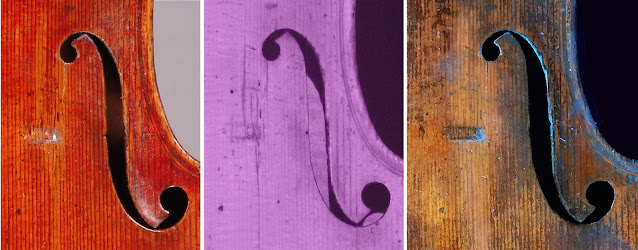Stradivari with a pinch of salt.
In 2021 the prestigious peer-reviewed journal of Chemistry, Angwandte Chemie published a multi-authored paper entitled Materials Engineering of Violins Soundboard by Stradivari and Guarneri. In turn, the paper was reported upon in the press around the world, endorsing some of the conclusions that it proposed, in particular the use of Borax as a wood treatment, and table salt to season the wood prior to construction. The abstract of the paper is given here:
We investigated the material properties of Cremonese soundboards using a wide range of spectroscopic, microscopic, and chemical techniques. We found similar types of spruce in Cremonese soundboards as in modern instrument, but Cremonese spruces exhibit unnatural elemental compositions and oxidisation patterns that suggest artificial manipulation. Combining analytical data and historical information, we may deduce the minerals being added and their potential functions - borax and metal sulfates for mineral suppression, table salt for moisture control, alum for molecular cross-linking, and potash or quicklime for alkaline treatment. The overall purpose may have been wood preservation or acoustic tuning. Hemicellulose fragmentation and altered cellulose nanostructure are observed in heavily treated Stradivari specimens, which show diminished second-harmonic generation signals. Guarneri's practice of cross linking wood fibres via alumnium coordination may also affect mechanical and acoustic properties. Our data suggest that old masters undertook materials engineering experiments to produce soundboards with unique properties.
This paper is not the first time that we have seen prestigious academic journals publish spurious articles in the name of research on topics surrounding the violins of Stradivari that have been successful in peer review. I offer the hypothesis that an investigation which satisfies the methodological requirements for peer review, and is not obviously wrong in its conclusions may reach the bar for publication. If there is any doubt in the minds of the editorial board, these tend to get the benefit of the doubt because of their popular attention-grabbing nature. Innumerable newspapers across the world picked up on this paper, where mainstream scientific work may not get any attention. However, there is a blind spot in the peer review system when no-one with specific experience of the subject matter is involved, and this is especially the case for subjects that are outside of the purview of the mainstream academic scientific community. The peer-reviewers will assume that the data is presented in good-faith, and will presume that the hypothesis presented with sufficient knowledge of the subject matter for the work to be good science.
When these things get into the newspapers, I am often overwhelmed with people bringing me this new information. Hence, after The Times of London published a report of the paper on September 25th 2021, I responded by letter. There seems no need to further elaborate on the fundamental issues that reveal grave concerns about the ethical foundations of this paper.
Sir, Your article, “Secret of the Stradivari sound revealed at last: table salt”, Sep 25 demonstrates difficulties that arise when analytical methods lack context. Borax is reported in these samples but was not widespread in Europe until the end of the nineteenth century. It is a routine precaution of 20th-century restorers against woodworm. Some Stradivari samples contain higher levels of sodium, chlorine and potassium than others, purported to be wood seasoning. Damage to violins may be caused by sweat, which also contains these elements. Cremonese violins, including Stradivaris, have common visual qualities that differentiate them from other violins and are famously difficult to replicate. It stretches credibility to believe that these craftsmen achieved consistency whilst pursuing inconsistent chemistry. Better reasoning is the unpredictable use and repair that these instruments have been subjected to over three centuries. Regrettably, we should take this research with a hefty pinch of salt.



Comments
Post a Comment